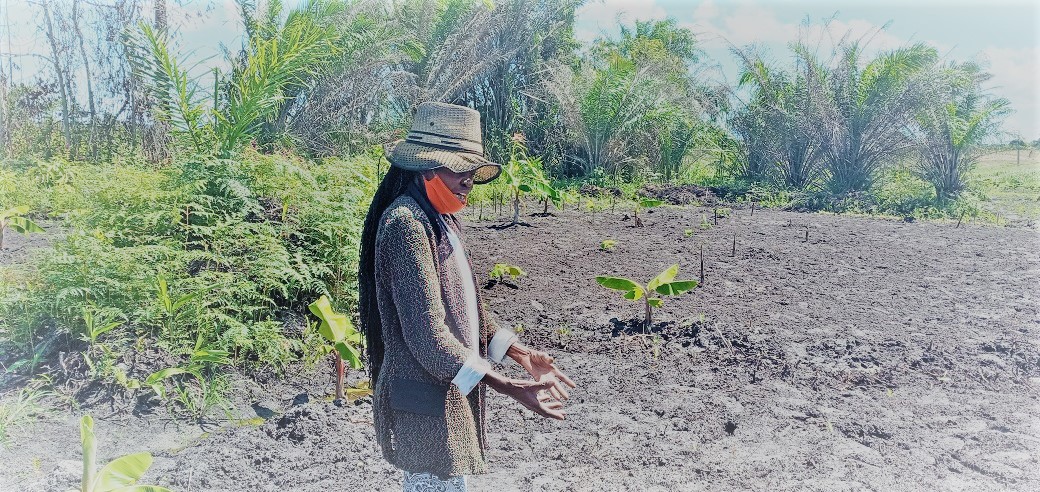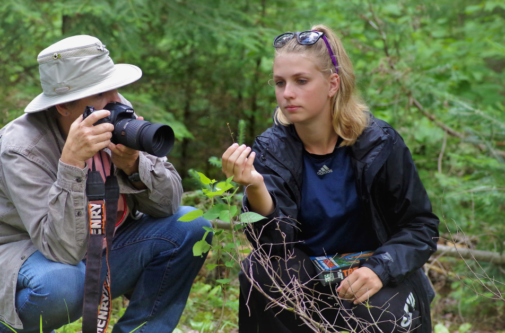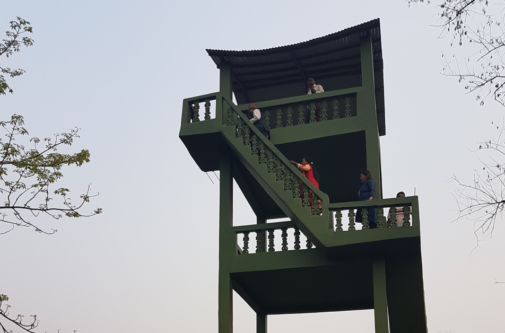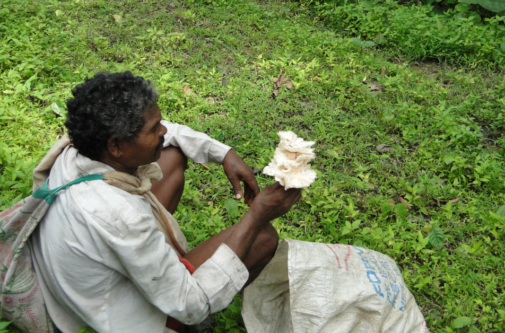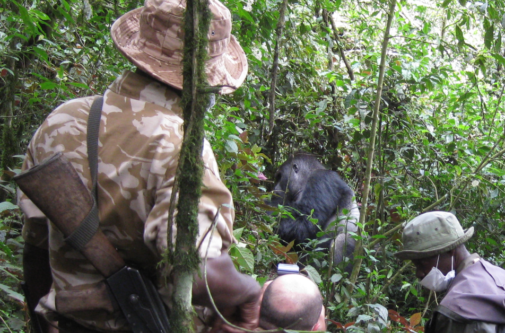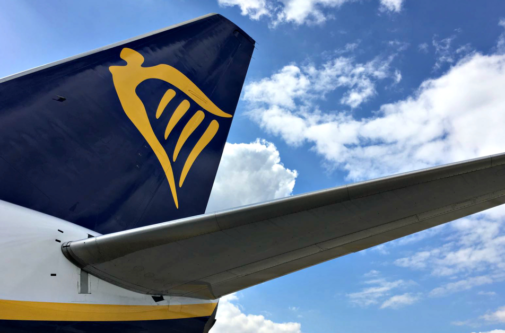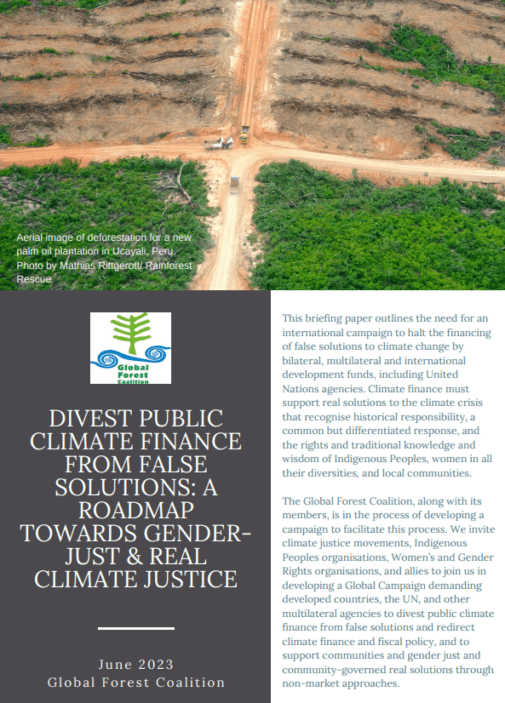Tourisme communautaire versus tourisme de masse : quelles sont les implications pour les forêts et les communautés ?

Tout au long de la pandémie, le secteur du tourisme a été durement touché : de nombreux pays ont été complètement confinés et de nombreuses personnes ont perdu leurs emplois ou, au contraire, ont pu travailler, en acceptant toutefois des conditions de travail plus dangereuses que jamais. Il est, sans aucun doute, le bon moment pour réexaminer les effets du tourisme à l’échelle mondiale afin d’imaginer des moyens de le modifier pour le bien des peuples et de la planète.
Continuer à lire en anglais…
This new report in our Forest Cover series highlights specific, local and national-level examples of tourism practices, with seven case studies developed by our member groups and an article on dangerous carbon offsetting in the aviation industry. These examples challenge us to think about issues such as ecotourist projects developed by Indigenous groups, community-managed tourism, strict protected areas, government policies, and more.
Common themes such as community conservation, the needs and roles of Indigenous Peoples and local communities and gender justice provide a rights-based lens to examine both the impacts that tourism can have on forests and communities, and the benefits that it can bring to livelihoods and biodiversity.
Download the report in English (web quality 3.1MB | low resolution 0.9MB)
The following translations are also available:
- Community-controlled ecotourism in the Ecuadorian Amazon, in Spanish
- The promise and risks of forest tourism in Russia, in Russian
- Income from tourism cannot compensate for Kahuzi-Biega National Park rights violations in DRC, in French
For more information on GFC’s work on tourism please see our Extractive Industries, Tourism and Infrastructure (ETI) campaign page.
Contents:
-
- Introduction: Reexamining tourism
- Community-controlled ecotourism in the Ecuadorian Amazon
- Community ecotourism in Canada helps people to get outdoors and protects wilderness areas
- Community-based versus corporate tourism in Nepal
- The promise and risks of forest tourism in Russia
- Achanakmar tiger sanctuary welcomes tourists but excludes Indigenous Peoples
- Income from tourism cannot compensate for Kahuzi-Biega National Park rights violations in DRC
- Aviation, carbon offsets and tourism: a recipe for disaster
Introduction: Reexamining tourism
By Megan Morrissey, Global Forest Coalition, USA and Hemantha Withanage, Centre for Environmental Justice and GFC Asia-Pacific regional focal point, Sri Lanka
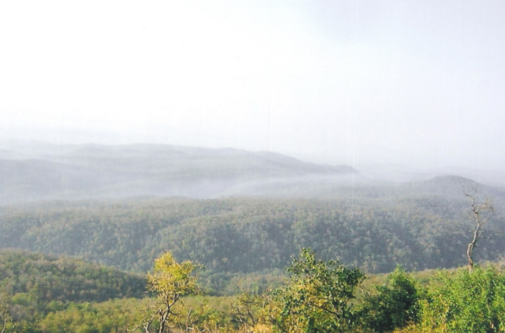
Morning mist over Achanakmar tiger reserve in India, where hundreds of families have been evicted from. Dr.SujoyMukherjee/Wikimedia Commons
In an episode of his podcast, the writer David Harvey explains that consumer demand is responsible for the bulk of economic growth, and that a key area of demand consists of “compensatory consumerism” – what we get in exchange for our working time. Tourism, Harvey says, is one form of “compensatory consumerism,” for it is something we enjoy as a pleasurable release in exchange for our labor and the drudgery of contemporary life in capitalist economies. The tourist industry exists to “sell the fantasy of the tourist holiday and the wonderful time you might have a sort of release from the misery and chores of daily life. Tourism plays upon that fantasy, advertises that fantasy, and it advertises this in various contexts like the beach and the tourist cruise,” Harvey says.
Writing and thinking about tourism at this particular moment in time is, of course, unlike writing and thinking about tourism at any other moment in recent history. That is because, as we all know, a deadly global pandemic suddenly stopped most tourist activity in its tracks, in addition to lots of our other everyday activities; whole cities and countries were locked down and many people became unable to go on doing their jobs, while others had to work more and in more dangerous health conditions than ever.
So, does it even make sense to examine tourism now? Arguably, it is a good time to reexamine this type of consumerism, to imagine the ways in which it could be altered for the good of people and the planet. Some countries like the United States have an almost 50% vaccination rate already, and others are still struggling to gain access to inoculations and are dealing with third- and fourth-wave COVID-19 impacts. As in so many other areas of life, inequality underlies everything when it comes to the virus, including how likely you are to be infected and die, how likely you are to see your income shrink (or grow; the world’s billionaires increased their fortunes by 54% during the first year of the pandemic), and how soon you will be reuniting with friends and family or booking a flight and a hotel.
In terms of the different ways that companies “sell the fantasy of the tourist holiday,” one increasingly popular version of the fantasy is that of the ecotourist retreat or adventure. Picture jungles and charismatic fauna, hikes to waterfalls, thatched-roof huts by the beach, shopping for Indigenous handicrafts. The idea behind ecotourism is to enjoy the natural environment and support its conservation, but whether or not such activities live up to this loose standard is often another matter, and something that has to be examined on a case-by-case basis. As we see in the example of the Dominican Republic and Cotubanamá Park, even an ecotourist resort made up of wood cabins that uses zero plastic and has water-saving faucets can be harmful to delicate local biodiversity and groundwater aquifers and set a dangerous precedent.
There are many specific, local and national-level examples of tourism practices considered in this issue, which contains seven case studies from seven countries and an article on dangerous carbon offsetting in the aviation industry. These examples challenge us to think about issues such as ecotourist projects developed by Indigenous groups, community-managed tourism, national parks and other types of protected areas, government policies, and more. It even pushes the boundaries of what we might think of as tourism, as the article from Canada analyses outdoor education by a local chapter of an environmental charity and posits that these smaller-scale types of engagement with the outdoors are what we need to reconnect with our environment in a moment like the pandemic.
Similarly, in Nepal, local-level ecotourism is practiced by Community Forests Users’ Groups who offer visitors activities such as hiking, fishing and homestays. The activities are regulated by the Forest Act, which includes principles of gender equality that favor women’s equal participation and leadership. This model, which involves a focus on protecting forests and biodiversity, is contrasted with the more harmful corporate tourism model. In Ecuador, the Indigenous rights organization Fundación Pachamama runs ecotourism projects as part of its work to advance the territorial and community rights of local communities in the Amazon, creating jobs and respecting local cultures and nature The organization has gender justice as a core value.
Critical analyses of tourism are offered in the articles on India, Russia, and the Democratic Republic of Congo. In India, sustainable tourism (defined here as tourism that can “make a positive contribution to the natural and cultural environment”) and ecotourism (tourism that is “nature-based”) is seen as being carried out with insufficient involvement of local communities, who should benefit more from this activity. Similarly, in Russia, tourism in northern forests is guided by the state bureaucracy and its “pursuit of profit at the expense of nature,” and Indigenous groups have been divided arbitrarily. In the Democratic Republic of Congo, a contentious national park relied on the expulsion of Indigenous Pygmy communities that have been violently repressed and impoverished in the name of tourism and wildlife preservation, their ancestral and territorial rights cast aside.
As always, there is more going on than what we can simply see “on the ground.” A critical article is included on the aviation industry, a contributor to global warming (unequally), and its dangerous carbon trading schemes. Here again we see the link between tourism and forests; carbon offsetting programs often amount to “dubious tree planting schemes or projects that claim to remove carbon through protecting forests” that are already being conserved by forest communities.
The articles included here consider common issues such as approaches to forests and biodiversity including community conservation initiatives, parks and World Heritage sites; the rights and roles in tourism of Indigenous Peoples and local communities; and gender justice. Gender is examined in terms of women’s key roles in advancing local tourism initiatives in the case studies from Canada, Nepal and Ecuador. According to the World Tourism Organization, women make up 54% of the tourism workforce and are consistently concentrated in low-paying and low-status employment in this industry, even performing essential unpaid labor for family tourism businesses. This of course means that women, who more often serve as informal workers, have disproportionately experienced the economic shock of COVID-19’s impact on tourism. At this juncture, it is worth asking what a feminist ecotourism would look like.
Despite the challenges dealt to the tourism industry in all its facets by the pandemic, there are indications that some sectors of the public are anxious to put the whole experience of the last year behind them and return to cruises and the like. In fact, after the ongoing deprivations and stresses of 2020-21, they may be even more anxious than ever to engage in this type of “compensatory consumerism.” Countries may also want to quickly resume selling the fantasy of the tourist holiday; for small island states like the Dominican Republic, nearly one in five dollars of the national GDP comes from tourism. The time is ripe for a critical reexamination of what this type of consumerism can and should be.
A successful campaign against an ecotourism resort in the Dominican Republic
 Ever seen a solondon or a rhinoceros iguana? If you do, it is likely thanks to environmentalists in the Dominican Republic who successfully thwarted a development project that threatened local biodiversity, including these endangered species.
Ever seen a solondon or a rhinoceros iguana? If you do, it is likely thanks to environmentalists in the Dominican Republic who successfully thwarted a development project that threatened local biodiversity, including these endangered species.
Not far from Punta Cana, one of the top tourist destinations in all of Latin America and the Caribbean, lies Cotubanamá National Park, a protected area established in 1975 that is the Dominican Republic’s biggest. Almost 800 square kilometers in size, this idyllic coastal park is home to two local communities, immense biodiversity and important archaeological sites. It is frequented by day-trippers – both domestic and international tourists – who pay entry fees to visit the park, and visitors can also stay in a few small inns in the towns.
Cotubanamá has been under threat of development for many years; in 2004, the government downgraded its western coastline to a “recreational area,” allowing development to occur as a secondary activity. This set the stage for incursion by developers like the Spanish-owned company, Globalia, which bought a plot of land there in 2000 to build an ecotourism resort. The purchase was made right after President Hipólito Mejía reduced the size of Cotubanamá by decree, and the new resort was to be just outside the old park’s borders. There were obstacles for Globalia based on environmental assessments until Environment Minister Angel Estévez greenlighted the project in 2018. Many were unaware of this fact until Globalia began bulldozing a forest area in January of 2020.
Civil society organized in opposition to the resort, which, despite its eco-friendly image, they believed would take a toll on water resources and set a dangerous precedent. A coalition of 12 organizations called the Coalition for the Defense of Protected Areas (formed in 2003) filed two legal complaints and carried out a social media campaign using the hashtag #SOSCotubanamá. The president’s office suspended Globalia’s construction work in late February, and a research commission was created, but with the participation of Environment Minister Estévez. The struggle to revoke Globalia’s environmental permit continued for months, with civil society protests, petitions, and a supreme court ruling, and it ultimately succeeded on August 12. The powerful interests in favor of development endure, however, and the Coalition is urging a broader societal debate about what kind of tourism people want to see in the Dominican Republic.
Community-controlled ecotourism in the Ecuadorian Amazon
By Fundación Pachamama, Ecuador
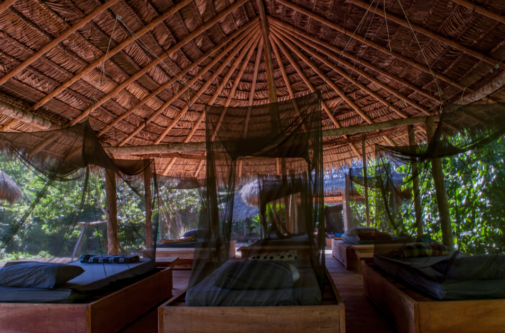
A dormitory at NAKU ecotourism resort in Ecuador, which provides a vital source of sustainable livelihoods for Indigenous communities. NAKU
Fundación Pachamama works with Indigenous communities across the Ecuadorian and Peruvian Amazon to support their self-autonomy and defend their rights and the rights of the territory they depend on. They also advocate against the expansion of large-scale extractive industries and extensive agriculture into the Amazon, which are the greatest threats to Indigenous Peoples and biodiversity there. Fundación Pachamama’s work was seen as such a threat that in 2013, the Ecuadorian government shut it down as punishment for its opposition to state plans to open up millions of hectares of rainforest to oil drilling companies.
Since it won its battle for reinstatement in 2017 the organization has redoubled its efforts to protect Indigenous cultures and biodiversity, particularly through the Sacred Headwaters Initiative, which aims to establish a protected region in Ecuador and Peru that is off-limits to industrial scale resource extraction and governed in accordance with traditional Indigenous principles.
Gender justice is an intrinsic element in the development, implementation, monitoring and evaluation of Fundación Pachamama’s projects. This ensures that they benefit Indigenous women and recognize their political, economic and sociocultural value. The organization acknowledges that Indigenous men and women have different relations to and knowledge about their forests, and the recognition of these different roles is vital to supporting them to build positive changes in their communities. This has also allowed important moments of reflection and organizational learning in the organization’s projects, which is reflected in the communities’ approach to political management at the local level.
The Fundación’s extensive work includes “Ikiama Nukuri” (Women protecting the forest), a program aiming to build collective power and amplify the voices of Indigenous women in order to improve maternal, infant and reproductive health. They also carry out broader capacity-building with Indigenous organizations so that they are better able to defend their own rights, and to support them in developing sustainable livelihoods and economic alternatives to extractivism. Part of this work involves support for community-based ecotourism developments, which are accessible and of benefit to the whole community.
Two of Ecuador’s flagship ecotourism projects are the Kapawi ecolodge in Achuar territory and Naku in Sápara territory. Although these sites are at different ends of the comfort scale, they share the key principles of community ownership and the protection of Indigenous cultures and biodiversity.
Kapawi ecolodge is in the territory of the Achuar Indigenous Peoples and is a luxurious ecotourism development with a capacity of 30 guests. It was founded in 1996 and was seen as a pioneer of community ecotourism in the region. In 2007, it received an investment of more than US $2 million, and at the same time ownership of the site was transferred to three communities who are responsible for its management, with another nine communities directly benefiting from it. The ecolodge has had a hugely positive impact in terms of creating local employment and protecting cultural values, ancestral knowledge and biodiversity. It has received around 12,000 visitors in total so far, 95% of which are foreign and mainly from the United States and European Union.
The Naku development is located in the territory of the Sápara Indigenous Peoples, which is recognized by UNESCO as a World Heritage site. The development involves more basic infrastructure that is easier to manage and focuses on using traditional medicinal knowledge to take visitors on a transformational experience. It provides local employment through the nearest school and works to preserve the Sápara Indigenous language, which is considered to be endangered. Naku is managed by a steering committee that is elected for a three-year term by a community assembly in which all residents are invited to participate. Although men often hold key committee positions, those responsible for the day-to-day running of the business such as cooking, housekeeping, guiding or caring is generally fairly evenly balanced between women and men, and a rota system ensures that each family can work for and benefit from Naku.
In 2020, both projects were closed for an extended period due to the pandemic, but their deep roots in the community and the strong links that they had fostered with visitors allowed them to survive and reopen. In Kapawi, the relationships that the lodge had built with guests meant that the donations and support it received whilst it was closed allowed it to welcome guests back again when it was safe to do so. Naku’s response to the pandemic was to create an online course to maintain relationships with visitors and offer them a new and alternative form of exchange and experience.
Fundación Pachamama is also keen to encourage more community-based ecotourism in Ecuador in recognition of the fact that ecotourism is still heavily dependent on visitors from the Global North who mainly fly long distances to get there. They would like to see more Ecuadorians visiting the ecotourism developments they support instead of going abroad. They also encourage foreign visitors to stay for longer and visit more places whilst they are there to make the most of the costs and impacts of travel.
Another important factor to consider is that travel within Ecuador and to the Ecuadorian Amazon is also reliant on flying (albeit in light aircraft) as road networks are very limited. Indigenous communities want to keep it this way, as road developments would bring deforestation, extractive industries and the destruction of Indigenous culture, whereas air travel in this case has far less impact.
Community ecotourism in Canada helps people to get outdoors and protects wilderness areas
By Elena Kreuzberg, Ottawa Valley Chapter of the Canadian Parks and Wilderness Society, Canada
Canada is a major ecotourism destination due to the diversity of its natural and cultural landscapes, intact wilderness in many preserved areas, and good tourism infrastructure. In 2019, the Canadian Government released a Federal Tourism Growth Strategy outlining the extraordinary potential for growth in the tourism industry and its power to drive development. The strategy includes Canada’s national parks, conservation areas, historic sites and UNESCO Biosphere Reserves and Global Geoparks as key destinations for sustainable tourism.
The industry suffered due to the COVID-19 pandemic in 2020-2021, and it will require significant support to restart. But the pandemic also demonstrated the necessity of outdoor time and exercise for people forced to stay home and work remotely, and generally to reduce stress and support psychological health for everyone. Forests and green areas around towns and cities are important in this sense. It also demonstrated societal demand for ecotourism services and our need to be in touch with our local environment. Ecotourism is key for understanding our natural surroundings.
An example of local ecotourism comes from the Ottawa Valley Chapter of the Canadian Parks and Wilderness Society (CPAWS-OV), created in 1969 by a group of citizens concerned about Gatineau Park. The group has been involved in wilderness protection in Eastern Ontario and Western Quebec, and it works to protect public lands in the National Capital Region and surrounding areas including through outreach programs. In 2012-2013, CPAWS-OV launched an educational initiative to engage youth and communities in nature conservation and foster respect for the Ottawa Valley’s wilderness, protected areas and forests. The program began with a situational analysis by allies and supporters, mainly the older generation of naturalists and concerned citizens, and primarily women volunteers and staff.
This environmental education program was developed to respond to the growing disconnect between children and nature for elementary school students in the Ottawa-Gatineau Region. Its goal was to provide quality outdoor and environmental education and foster citizens’ interest in parks and protected areas. We contacted schools to organize hikes and trips with kids to explore nature in the Ottawa Greenbelt. Another important task was to promote awareness of ecological principles and the inherent value of wilderness and forests. Before the pandemic, the youth program was available to most local schools. This program also provided educational programming for kids from new immigrant communities, offering them practical experiences with local nature conservation.
It is interesting that, in terms of gender engagement, young women have tended to coordinate the ecological education program and volunteer activities at CPAWS-OV, taking the lead in building conservation policies and actions. Young women interns have headed outreach and public awareness campaigns and expanded youth education activities to include high schools and universities. For example, the campaign in Gatineau Park to “make it a real park” brought together many young people, ensuring their involvement in the protection of wilderness and forests.
This and other campaigns provided opportunities for recent women graduates to gain fieldwork experience by collecting scientific data for the program on road ecology, organizational experience through outreach efforts, and teaching experience through the public hiking program. The internships were supported by the Canada Summer Jobs program, Colleges and Institutes Canada and the WWF-Loblaws Water Fund, and CPAWS-OV later created permanent positions for education and outreach coordinators, both of which were staffed by young women who were former interns.
In summer 2016, CPAWS-OV organized a Bioblitz field survey on the Dumoine River with volunteers of all ages, and this led to the creation the following year of an annual “Art Camp” in the surrounding intact forest area, which has many rapids and waterfalls. The camp sponsors selected artists, naturalists and youth to capture the beauty of the Robinson Lake and Grand Shute area through artistic means and thus inspire continued protection of this amazing wild forest landscape. After the camp, CPAWS-OV has organized public events with artists, allies, policy-makers and other stakeholders which helps raise funds for conservation work of the organization.
The participatory approach and focus on community engagement has strengthened the campaign to expand protected areas in the Dumoine, Noire and Coulonge Watersheds, which contain the last remaining large and pristine landscapes in southern Canada. CPAWS-OV intends to build an interconnected network of protected areas around those three watersheds that protects the richness of the landscape and ensures connections between forests of the Ottawa Valley and the boreal forests, as well as providing meaningful jobs and investments in local communities based on ecotourism and sustainable development.
The ecotourism initiative by CPAWS-OV provided opportunities for organizational capacity building and fostered education and public outreach programs as well as increased public interest in parks and protected areas in Ottawa Valley and citizen involvement in conservation programs. Under COVID-19, the public hikes and outdoor events were postponed. However, the analysis of public demand for recreation and outdoor education suggests that the community-based ecotourism should soon be resumed and expanded.
Community-based versus corporate tourism in Nepal
By Dil Raj Khanal and Anila Onta, Federation of community Forestry Users Nepal
Nepal’s mountains, protected areas, World Heritage sites, rivers and community forests attract thousands of international and domestic tourists each year, contributing about 3% of GDP and creating two million formal jobs in the sector. [1] However, two contrasting models of tourism often conflict with each other, with one being a vital source of livelihoods for impoverished forest-dependent families and women and the other resulting in rights violations and harm to biodiversity.
Community-governed forests in Nepal are an increasingly popular destination for tourists and have become an integral part of the community forest model in Nepal. Many community forest groups (CFGs) now manage community-based ecotourism activities at the local level, providing much-needed income for poor forest-dependent families and a key source of livelihoods for many communities.
Ecotourism activities vary throughout the country, with CFGs in the mid-hill areas managing their forest landscapes and hiking areas for nature walks, bird watching, hiking and photography. CFGs in lowland areas (the Terai) tend to manage and conserve natural wetlands and parks, providing boating and fishing activities for tourists. Wildlife conservation is also central to CFG ecotourism, with hundreds of groups managing mini-zoos, wildlife rescue centers and community viewing towers for conservation and education purposes.
Another popular activity offered by CFGs are community homestays, which are managed entirely by individual households. These allow tourists to experience traditional ways of life by staying in the communities. Some of the CFGs also manage Community Information Centers to educate tourists about community forests and ensure respect for socio-cultural values and in particular sacred sites. The centers are also used as training centers to share traditional knowledge, and as venues for cultural events.
Gender equality is built into the community forest ecotourism model. Nepal’s Forest Act stipulates that CFGs must be formed by households and not individuals, and the involvement of at least one female and one male member of each household is required. Government guidelines for community forestry also highlight the importance of empowering young women and youth in general to participate in the leadership of CFGs such as in executive committees, which require the equal participation of women and men. The community forest law also requires that micro-enterprise and ecotourism activities must involve equal participation, and that women and girls are actively involved in planning and implementation processes.
In stark contrast to the community forest ecotourism model, corporate tourism harms mountain ranges, rivers and sacred sites through developments that cause pollution and destroy biodiversity. For example, a large number of poorly-conducted jungle safaris disturb wildlife habitats across the country. In general, tour operators are also less sensitive towards and fail to respect the socio-cultural norms and values of Indigenous Peoples, local communities and women. These groups tend to have the least say in how corporate tourism is carried out, and there are no legal provisions for ensuring their participation in consultation, decision-making or planning processes. As a consequence, women’s participation in the corporate tourism sector is severely limited.
Companies involved in corporate tourism have also captured community forest areas [2] without the free, prior and informed consent of local communities for the construction of hotels, resorts, cable car developments and other infrastructure. This has resulted in land-grabbing and rights violations [3] and forced local communities including women’s rights groups to come together to organize campaigns against corporate capture and to enforce social and environmental safeguards.
In order to effectively implement community land and resource rights, there is an urgent need to raise community awareness about these issues and enhance their capacity to assert legal community rights over forest land.
A challenge common to both tourism models is that there is still a lack of legal provisions and mechanisms to ensure that benefits from tourism are shared equitably between and within the local communities involved. This is felt particularly acutely in the case of corporate tourism, where an unequal distribution of revenue deprives communities whilst forcing them to shoulder the negative impacts of it at the same time.
Although the benefits of community forest ecotourism are clear, both in terms of the protection of forests and biodiversity and opportunities for generating sustainable livelihoods, government agencies still lack support for it. Much more work could be done to empower community forest groups to incorporate ecotourism into their forest management plans and provide them with the tools to do so.
This is especially important given the impacts of COVID-19, as travel restrictions have seriously limited tourist numbers and therefore the incomes of local communities. However, the resilience of the community forest model has undoubtedly helped, with communities developing virtual tourism opportunities and applying health and safety measures to address these challenges.
[1] 1 National Planning Commission (NPC), 15th Development Plan (2019-2023), National Planning Commission, Kathmandu, Nepal
[2] Andreas Neef, 2019. Tourism, Land Grabs and Displacement, a Study with Particular Focus on the Global South, Auckland.
[3] Janardan Poudel, 2014. Socio-Cultural Impact in Tourism: A Case Study of Sauraha, Nepal. JOURNAL OF ADVANCED ACADEMIC RESEARCH (JAAR). Vol. 1. No. II,
The promise and risks of forest tourism in Russia
By Anatoly Lebedev, BROC, Russia
Tourism is a massive industry that has turned the experience of coming into contact with someone else’s nature and culture into a need for millions of people. And Russia’s taiga forests, as an object of interest for tourists and the general population, are enmeshed in this process.
The quarantine year, of course, caused serious damage to all industries and small businesses tied to and dependent on tourism. For countries with large forested areas, such as Russia, which has many taiga sites that draw tourists, border closures meant only a change in the direction of travel (from international to domestic). The government adopted a number of strategies and laws to bolster the development of both the tourism and forestry sectors in 2020, including in protected areas, which has led to serious problems for conservation and forest communities.
At particular risk are the pearls of Russian nature, the virgin forests of Kamchatka, Baikal, and the Western Caucasus. No laws and regulations limit tourist activity in Russia; it is growing steadily in the form of ski resorts, “biosphere ranges,” fishing, hunting and camping sites. The impetus for the development of these activities in forests and protected areas comes from two directions: from above, through weakening protections for nature reserves and national parks in favor of tourism; and from below, through the marketing of tourism in protected forests that are vital to local communities. Both have the same underlying aim: the pursuit of profit at the expense of nature, as if it were the sole property of the state.
We should not be fooled into thinking that tourism organized by the administrations of protected areas will ensure the preservation of forest ecosystems. The directors of the nature reserves are dependent on the Moscow bureaucracy with its unquenchable thirst for profit, and dissenting directors are simply replaced with loyal ones. Dozens of examples of this exist.
As a result, tourism in protected areas creates a destructive vicious circle. Tourist activity is increasing, the incomes of the protected areas and the governing Ministry are growing, but the quality of previously pristine forest ecosystems is also declining. Workers in protected areas have rising incomes. But the purpose of protected areas is the protection of biodiversity, which can be vaguely defined. True biodiversity protection is a scientific matter, but instead, under the guise of this notion, groups of tourists are shuttled to the taiga.
A key example comes from Vitaliy Ryabtzev from Irkutsk, an activist and defender of Lake Baikal, a World Heritage site and the world’s largest freshwater lake. He describes how so-called “Baikal eaters” have in recent years succeeded in pushing a set of legal changes that have reduced environmental restrictions in the area through legal loopholes. Numerous permits for construction and commercial tourism developments have been granted at the municipal level over the years, and this illegal process has been impossible to stop. State media stresses the interests of “local communities,” which are always backed by the interests of the tourism industry.
Quite remarkably, there is a bill under consideration in congress in the State Duma that would allow so-called sport hunting in protected areas as a “recreational” activity, which is legally equal to tourism. In the eyes of the environmentalist community, it is a sign of the complete dismantling of the whole system of Russian conservation and environmental protection.
Also important to mention is the heavily promoted tourism in the Arctic as part of the Arctic zone’s accession into the sphere of responsibility of the Ministry for the Development of the Russian Far East. First, tourism has long been an important area of activity for the Indigenous communities of Siberia and the Far East, including those traditionally living in the pre-tundra forests of Siberia. But in Russia, where the internationally recognized principle of free, prior and informed consent in advance of any economic activity (FPIC) is still little known and not officially recognized, an important question arises as to who is the legal beneficiary of such tourism in the Arctic forest-tundra. If it is the communities themselves, that is one thing, but if tourism is carried out on the initiative of the Ministry for the Development of the Russian Far East and with the help of outside investors, then it is time to sound the alarm.
Aboriginal forests and tundra will be trampled down very quickly, and the reindeer herds—the basis of aboriginal life—will simply die out. In addition, in the new Governmental Strategy on Arctic development, the identification of the Indigenous Peoples of the Arctic as beneficiaries requiring special support in contrast to the Indigenous Peoples of the rest of Siberia and the Far East creates a dangerous precedent for a split in the identity of a single community of Indigenous Peoples of the Russian Federation. The forest peoples of southern Siberia who are suffering from incursions by extractivist projects in coal, gold and other minerals are thus deprived of state support. Legally, there is no clear border between Arctic and other Indigenous tribes here, and the forest-tundra geographic border is moving rapidly northwards and with it forestry-related activities and accompanying problems. Thus, the Arctic development strategy, providing privileges for Arctic Indigenous communities without their clear identification, will cause conflicts along unclear borders between tribes.
To summarize, tourism as a form of land and resource use may be a way to support conservation activities if governments and communities agree on this and act together. However, in Russia, where the federal government is completely dependent on resource-concerned monopolies, municipalities are woefully under-funded and community interests are ignored, all of this leads to a high risk of environmental destruction for the key intact ecosystems of Siberia and the Far East.
Achanakmar tiger sanctuary welcomes tourists but excludes Indigenous Peoples
By Kanta Marathe, All India Forum of Forest Movements, and Devjit Nandi, Navrachna, India
India has seen a large increase in international tourism in recent years, with nature-based or ecotourism becoming an important sub-sector of the industry. This type of tourism focuses on wildlife in protected areas and sanctuaries and is sold as a way for tourists to help protect endangered species. However, ecotourism in India is also resulting in a loss of the commons through the privatization of protected areas. Experience shows that the industry lacks the involvement of local communities and is just as likely to disrupt, disturb and damage wildlife habitats as it is to protect them. The same can be said for the cultures and livelihoods of local communities.
In most of India’s protected areas, tourism of one form or another has been promoted, often on forest land. At the same time, Forest Departments follow the principle that no human habitation should take place inside strictly protected areas, a contradiction which has led to many conflicts. [1] For example, a critical recent study on Tayorana National Park highlighted how such neo-liberal policies have impacted local livelihood strategies. [2]
The state of Chhattisgarh has been lauded by the government of India for having “maximum tourist potential,” with its 44% forest cover, 11 wildlife sanctuaries, three national parks and one biosphere reserve. Chhattisgarh’s Achanakmar wildlife sanctuary covers 552 km2 of forests and has been declared a critical tiger habitat. Achanakmar is also home to the Baiga tribe, one of the most vulnerable tribal groups in India that has lived in this region for centuries. The sanctuary was established in 1975 after the signing of the Wildlife Protection Act, and included in Project Tiger in 2009, a government program aiming to halt the population decline of India’s big cats. Under the direction of the National Tiger Conservation Authority, state Forest Departments are required to declare protected areas for critical tiger habitats and to relocate villages from within them according to guidelines that are supposed to protect the rights of forest dwellers.
Six villages were relocated from Achanakmar wildlife sanctuary between 2009 and 2011 which included 249 families whose rights were violated in the process. They were given inadequate financial compensation, most of which they did not receive directly but instead was used by the Forest Department for “housing and infrastructure developments,” which were in poor condition, and led many of the displaced families to construct their own huts in the vicinity. Only after the courts intervened in 2014 were land entitlements of five acres distributed to the displaced families. However, their land still has not been legally demarcated by the Forest Department, making the families reluctant to cultivate potentially disputed land.
Achanakmar wildlife sanctuary has various government-run and private hotels and guest houses, as well as restaurants and resorts. The pandemic has impacted the sanctuary significantly, with age restrictions, a 50% capacity limit and escalating costs due to cleaning requirements. The most significant impact has been felt by local communities, who have been banned from collecting non-timber forest products (NTFP), which they rely on for their sustenance, livelihoods, health and well-being.
Local perceptions of the tiger reserve and the tourism it has created vary significantly depending on the main livelihood activity of the person being asked. The livelihoods of almost 50% of local residents depend on tourism and the sanctuary, and around 45% of people depend on agriculture and the collection of NTFP. Navrachna interviewed 100 people in July 2020 [3] that are involved in a range of livelihood activities to assess their perceptions and found that people engaged in and dependent on tourism, such as tourist guides, shopkeepers and lodge owners, believe that the sanctuary is vital for wildlife protection and that tourists bring economic prosperity to the area. They also support the ban on hunting and the collection of NTFP and believe that the forests should be for wildlife, and not human habitation.
The perception of Baiga forest dwellers is far different. Indigenous women in particular were outspoken about the fact that they had been thrown out of their forests and traditional homelands since the establishment of sanctuary, they were regularly banned from accessing forest resources, their culture had been destroyed and outsiders were allowed to benefit at their expense. Although Baiga communities also want wildlife to be protected, they believe that they also have a right to live in and benefit from their ancestral lands. The ban on the collection of NTFP directly impacts \their main livelihood activity, and in fact cameras have been installed in the sanctuary to catch trespassers rather than tigers. They are also critical of tourists, who they say harm the forest through littering and are contributing to a loss of animal and plant diversity.
Whileit is clear that tourism generates significant employment in Achanakmar, it has also had numerous negative impacts on the local Indigenous population. Tourism developments should benefit local residents inclusively, with opportunities and benefits shared fairly. The cultures of forest communities and Indigenous Peoples should be protected and respected, and they should be involved in planning and decision-making so that tourism can be a positive development for all of the people in the area and its forests and wildlife.
[1] Sabarwal, V., Rangarajan, M., and Kothari, A. 2001. People, Parks and Wildlife: Towards Coexistence. Tracts for the Times 14. Orient Longman, New Delhi.
[2] Ojeda, D., 2011. Whose Paradise? Conservation, Tourism and land grabbing in Tayrona National Park, Colombia. Land Deal Politics Initiative. Presented at the International Conference on Global Land Grabbing 6-8, April 2011.
[3] Interviewees consisted of tour guides (20), shopkeepers (10), Forest Rights Protection Committee members (20), lodge owners (10) , tribal people and forest dwellers (30) and Adivasi women leaders (10). The shopkeepers, lodge owners and Adivasi women leaders were selected through purposive sampling, while the others were selected randomly. The tribal people, forest dwellers and members of the Forest Rights Protection Committee were interviewed in five villages where Navrachna has previously worked, and the interviewees were known to Navrachna.
Income from tourism cannot compensate for Kahuzi-Biega National Park rights violations in DRC
By John Ciza, Francine Bintu, Thank God Munguakonkwa and Alain Bisimwa, FCPEEP, DRC
In the 1960s and ‘70s, around 6,000 Indigenous Pygmies were violently evicted from Kahuzi-Biega National Park in South Kivu, in eastern Democratic Republic of the Congo (DRC). With no legal land titles and a total disregard for their customary rights to ancestral lands, the Indigenous communities now living on the fringes of the Park impoverished are criminalized by Park authorities and the military.
The DRC has not demarcated the lands and territories of Indigenous Peoples, and Congolese law contains no mechanism guaranteeing their free, prior and informed consent to decisions that affect them. Protected areas and concessions are therefore established on their lands without consulting them and without paying them any compensation. The lands of these communities are often identified as unoccupied and classified as “vacant,” meaning that the state can do as it wishes with them.
This is the case with Kahuzi-Biega National Park, which was established in the 1950s and is one of DRC’s five World Heritage sites. [1] Since 1997, it has also been on UNESCO’s list of World Heritage in Danger. The Park’s 6,000 km2 are highly biodiverse, but the rarest and most sought-after species is Grauer’s Gorilla (Gorilla beringei graueri), which is the Park’s biggest attraction.
The Pygmies were expelled from the Park without compensation, and those who resisted lost their lives. Communities were removed by authorities by various coercive means; for example, some were told that if they did not leave voluntarily, they would be massacred by the rebel groups present in the area. As a consequence of the strict enforcement of Park rules, local populations have had to access its resources in secret, which has caused further conflicts and contributed to environmental degradation.
Armed clashes between Pygmies and Park guards are ongoing, claiming victims on both sides. In 2017, a father and son were shot for collecting medicinal herbs within the Park’s boundary, killing the son. In 2018, 45 houses were burned down in order to force farmers to leave a corridor area linking two areas of the Park. And in 2020, a sham military tribunal sentenced six Pygmy men and two women to 15 years and one year in prison respectively, for farming on their ancestral lands.
Decades of insecure land tenure, restricted access to forest resources and a lack of land on which to grow food has also led communities to become economically dependent on tourism linked to the Park. Before the pandemic, a large number of Indigenous Pygmy men, women and children living on the edge of the Park survived off income from the Park’s domestic and international visitors, for example by selling agricultural products and handicrafts to tourists. These vital income-generating activities had a ripple effect, improving the living conditions of households, creating jobs and reducing poverty. They also contributed to gender equality by providing livelihood opportunities for women that strengthened their power in the community. However, travel restrictions due to the pandemic have meant that many households have lost their means of economic survival, highlighting how an economic over-reliance on Park tourism is detrimental to Indigenous communities.
Through its direct economic benefits, tourism has the potential to contribute effectively to the fight against poverty in DRC, in particular by providing a market for crafts and local commerce. [2] It can also contribute to the protection of natural spaces and historic sites, as well as to the enhancement of local cultures. It can help to provide training so that young people can find jobs locally and encourage infrastructure development that can benefit Indigenous populations such as wastewater treatment plants and water and energy distribution networks, thus helping to raise the standard of living of rural communities. [3]
However, for tourism to fulfill this role in and around Kahuzi-Biega National Park, Indigenous populations must have stronger access to land ownership, and measures must be taken to guarantee the effective consultation and participation of Pygmies in decision-making and in the management of Indigenous lands. It is also necessary for the government and authorities to work with Pygmy communities expelled from the Park in mediation and reconciliation processes, especially in the ongoing context of conflict.
At the same time, Indigenous Peoples must continue and strengthen their own efforts and initiatives to safeguard their rights to land and resources. This includes mapping their ancestral territories to accurately indicate their traditional land ownership and land use practices, an important step towards the recognition and legal protection of their rights.
Finally, the marginalization of DRC’s Indigenous Pygmy population is a reality that governors, Congolese civil society and actors at all levels must work to overcome if the lives and livelihoods of Pygmies expelled from Kahuzi-Biega National Park are to be improved, and if the abuse and trauma they have suffered by is to be avoided elsewhere.
[1] Institut Congolais pour la Conservation de la Nature, Plan général de gestion du Parc National de Kahuzi-Biega (2009-2019), Kinshasa, 2009, p. 6.
[2] Gérard Ruiz, Le tourisme durable : un nouveau modèle de développement touristique ?, IRIS éditions : Revue internationale et stratégique, 2013/2 n° 90, p.101, disponible sur : https://www.cairn.info/revue-internationale-et-strategique-2013-2-page-97.htm
[3] Gérard Ruiz, Op.cit., p.101.
Aviation, carbon offsets and tourism: a recipe for disaster
By Coraina de la Plaza, Global Forest Coalition, Spain
Flying is the most polluting means of transport, and in pre-pandemic times, the aviation industry had the fastest growing greenhouse gas emissions of any sector. In 2019, it accounted for 2.5% of global CO2 emissions, equivalent to almost a billion metric tons each year, and an increase of 29% since 2013.
Aviation is also a prime example of differentiated responsibility for the causes of climate change, since only 1% of the global population causes 50% of commercial aviation emissions, and 80% of the world’s population has never flown. The strong link between aviation and tourism is clear; the UN World Tourism Organization (WTO) estimates that, in 2016, almost 60% of all tourism-related arrivals were by air, with overall transport-related emissions from tourism representing 22% of global transport emissions, and 5% of all anthropogenic emissions. According to a 2019 estimate by the WTO, between now and 2030, the number of tourism arrivals by air is expected to grow by over 50%.
The aviation industry has been put under the microscope in recent years by social movements and campaigns pressuring it to address its climate impacts. But instead of addressing these urgent issues, the industry has opted to continue business as usual, putting profit over people and the planet and devising schemes to offset emissions through carbon trading instead of cutting them by reducing air travel.
The industry is also using greenwashing to fool passengers and tourists into believing that they can fly as much as they want as long as they pay a modest amount to offset the emissions caused by their travel. These carbon offset projects are very often dubious tree planting schemes or projects that claim to remove carbon through protecting forests, when in fact the forests were already being conserved by women, Indigenous Peoples and local communities. An example is Ireland’s Ryanair, whose advertisements were banned for making misleading CO2 emissions claims and portraying itself as having the lowest carbon emissions of any major airline.
Aviation offsetting is also supported by intergovernmental climate-related processes and schemes. An example is the UN offsets platform, where individuals, companies and public bodies can offset theirCO2 emissions from flying and other activities for as little as US $1 per ton. And there is also the “Carbon Offsetting and Reduction Scheme for International Aviation” (CORSIA), a global scheme to offset greenhouse gas emissions from aviation that began its pilot phase this year. The Clean Development Mechanism (CDM) is one of the programs approved under CORSIA, whereby airlines will be able to purchase carbon credits sold by CDM projects that meet certain eligibility criteria.
CDM Project 8609 is registered by V&M Florestal, owned by Vallourec, a transnational steel- producer, and involves charcoal production for Vallourec’s steel plants in the state of Minas Gerais in Brazil. The project claims emissions reductions through small increases in efficiency and reduced methane emissions in its charcoal production facilities, which produce charcoal from monoculture eucalyptus plantations (also owned by the same company) across the state. It claims a reduction of 204,471 tonnes of CO2 equivalent per year.
However, the company uses flawed CDM carbon accounting methodologies to calculate reductions that treat all carbon dioxide emissions from the production and combustion of charcoal from eucalyptus plantations as zero, because industrial-scale bioenergy is wrongly deemed to be renewable and therefore carbon neutral.
The CDM also ignores the fact that extensive eucalyptus plantations in Minas Gerais, as in other areas of Brazil and around the world, are associated with deforestation, water scarcity and pollution from the use of agrochemicals. Further still, Vallourec’s poor track record includes direct conflict with communities, land-grabbing, the devastation of local ecosystems and biodiversity, as well as of traditional ways of life and the banishment of family agriculture. But these negative environmental and social impacts are also ignored.
Vallourec’s CDM project is therefore an excellent example of how offsetting through emissions trading can actually reward companies for highly polluting and damaging activities while at the same time allowing other polluting industries, such as aviation, to continue to emit. It demonstrates why offsetting emissions from aviation is such a bad climate solution and why rolling-out CORSIA at scale would be a disaster for communities and the climate.
A recent investigation also exposed how other carbon offsetting schemes used by some of the major airlines are based on flawed accounting systems, including forest offset and REDD+ projects. It showed how even the most “prestigious” certification schemes cannot guarantee emissions reductions, or that projects haven’t caused harm to communities living in and around the areas where offsets are generated.
The COVID-19 pandemic has clearly impacted both international travel and tourism due to travel restrictions and increased anxiety over the perceived risks of travel. However, preliminary studies of tourists’ perceptions show only a minor decline in willingness to travel post-pandemic, suggesting that the industry could return to “normal” relatively quickly.
Before a return to pre-pandemic ways, there is therefore an urgent need to permanently and radically scale down aviation, and this will have consequences for many people around the globe. A roll-out of just transition plans at scale are long overdue, not only for workers in the aviation sector but also for sectors that are highly dependent on aviation, with tourism being the most prominent. Critical dialogues, inclusive joint planning and the involvement of tourism-dependent communities (including diverse and underrepresented groups) and other rights-holders are central to developing these just transition plans.
Editorial Team:Andrey Laletin, Coraina de la Plaza, Jeanette Sequeira, Juana Delgado, Kwami Kpondzo, Megan Morrissey, Oliver Munnion and Simone Lovera
Editors: Oliver Munnion and Megan Morrissey
Translators: Andrey Laletin, Elena Kreuzberg, Kwami Kpondzo and Megan Morrissey
Design: Oliver Munnion
This publication has been produced with the assistance of the JMG Foundation. The contents of this publication are the sole responsibility of the Global Forest Coalition and can in no way be taken to reflect the views of donors.

